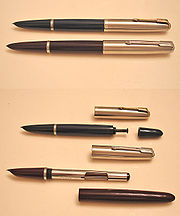
Parker 51
Encyclopedia

Fountain pen
A fountain pen is a nib pen that, unlike its predecessor the dip pen, contains an internal reservoir of water-based liquid ink. The pen draws ink from the reservoir through a feed to the nib and deposits it on paper via a combination of gravity and capillary action...
. Parker’s period advertising called it “The World’s Most Wanted Pen,” and this assertion was true although a little deceptive; the U.S.A. entered World War II
World War II
World War II, or the Second World War , was a global conflict lasting from 1939 to 1945, involving most of the world's nations—including all of the great powers—eventually forming two opposing military alliances: the Allies and the Axis...
in December 1941, and the War Production Board
War Production Board
The War Production Board was established as a government agency on January 16, 1942 by executive order of Franklin D. Roosevelt.The purpose of the board was to regulate the production and allocation of materials and fuel during World War II in the United States...
placed severe restrictions on production of pens for civilian sale. Parker's continued advertising during the war created a demand that took several years to fulfill after the end of the war. The pen was developed for use not with Parker's regular ink Quink
Quink
Quink is an ink developed by The Parker Pen Company and Francisco Quisumbing, a Filipino chemist....
, but with a new formula ink, advertised with the slogan, "writes dry with wet ink".
Unfortunately, this new ink's high alkalinity and isopropyl alcohol
Isopropyl alcohol
Isopropyl alcohol is a common name for a chemical compound with the molecular formula C3H8O. It is a colorless, flammable chemical compound with a strong odor...
content were fatally corrosive to the celluloid
Celluloid
Celluloid is the name of a class of compounds created from nitrocellulose and camphor, plus dyes and other agents. Generally regarded to be the first thermoplastic, it was first created as Parkesine in 1862 and as Xylonite in 1869, before being registered as Celluloid in 1870. Celluloid is...
then used for the bodies of most pens (including the Parker Vacumatic
Parker Vacumatic
The Parker Vacumatic fountain pen was launched in 1933, displacing the Duofold as Parker's top-of-the-line product. The pen was originally named the Golden Arrow, a reference to the new arrow clip which would go on to become a Parker trademark, appearing in some form on almost all of Parker’s...
, the company's flagship pen during the 1930s). Making the "51" pen's body and inner cap of a new plastic called Lucite, just coming into use for airplane canopies — and plastering the bottle, cap, and box with warnings not to use the ink in any pen "not even other Parker pens", except for the "51" — solved the corrosion problem somewhat.
The pen and the ink were both named "51" to mark 1939, the company's 51st year of existence, during which development was completed (U.S. design patent
Patent
A patent is a form of intellectual property. It consists of a set of exclusive rights granted by a sovereign state to an inventor or their assignee for a limited period of time in exchange for the public disclosure of an invention....
No. 116,097). By giving the pen a number instead of a name, Parker avoided the problem of translating a name into other languages.
The "51" was revolutionary at the time, with its hooded, tubular nib and multi-finned collector, all designed to work in conjunction with the pen's proprietary ink, allowing the nib to stay wet and lay down an even line with either the ultra-fast drying ink or more traditional inks.
With various refinements, the "51" stayed in production until 1972. The most significant design change came in 1948, with the introduction of the much improved Aerometric filling system. At the same time, Parker reformulated its ink, reducing the alkalinity, adding a selection of brilliant colors, and calling the new product Superchrome. Like the "51" ink, it also came with a warning that it should be used only in the Parker "51" (or its new little brother, the "31"), but the warning was more discreet.
The pen's resemblance to the P-51 Mustang
P-51 Mustang
The North American Aviation P-51 Mustang was an American long-range, single-seat fighter and fighter-bomber used during World War II, the Korean War and in several other conflicts...
, a fighter plane used extensively during the war, had no bearing on its name; but Parker took advantage of the coincidence by comparing the pen and the plane in its advertising. Additionally, a pilot who is suspected of falsifying flight records in his logbook in order to overstate his actual experience is said to have logged "P-51 hours," relying on the ambiguity of the term "P-51" to avoid directly confronting the suspect.
The "51" is among the most popular pen models sought out by pen collectors, and in 2002 Parker issued a lookalike model called the 51 Special Edition. In 2004, the larger and heavier Parker 100
Parker 100
The Parker 100 was introduced in 2004 and was retired in 2007. The pen was designed by the Parker Pen Company to bridge the large gap between the Sonnet & Duofold lines. The design of the 100 was meant to be a sleeker updated design of the classic Parker 51, which was a bestselling pen for the...
was released.
External links
- Parker 51 (Penpedia entry for production history of the Parker 51)
- Parker 51 (Review of book about the Parker "51")
- Parker 51 Special Edition (Originally official site for limited reissue of Parker 51, but seems to have other news about Parker pens, too.)
- Profile: The Parker "51" (Profile of the Parker "51" including information on dating and colours)
- The Parker "51" Website (Self-described as "The definitive site on the Parker 51 Fountain Pen".)

